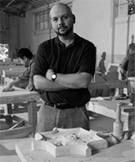Introducing the Elizabeth Scott Fireplace Collection by Atelier Jouvence:
Beautiful fireplaces for any décor. View the full collection! >
Master Stone Carver Olivier Dumont
Olivier Dumont is one of only a handful of French master stone carvers currently working in the U.S. A native of Dijon, France, Mr. Dumont was trained in traditional French stone carving techniques by some of Europe’s top stone carvers.
 Prior to coming to the U.S., he worked for several years as a professional stone carver, working on a wide range of carving projects, and restoration work on historic buildings throughout France. His background also includes training in art history and interior design.
Prior to coming to the U.S., he worked for several years as a professional stone carver, working on a wide range of carving projects, and restoration work on historic buildings throughout France. His background also includes training in art history and interior design.
In 2000, Olivier Dumont and his American business partner, Sonia, established Atelier Jouvence Custom Stoneworks in Chicago, Illinois. (“Atelier” means “artist’s workshop” in French; “Jouvence” is the street where Dumont lived in Dijon, France.)
Chicago Magazine recently profiled Dumont, saying, “Olivier Dumont, principal carver here, proves that fireplace mantels, staircases, columns, and fountains can still be made the old -fashioned way…”. The following is an interview with master stone carver Olivier Dumont:
Q.What do you enjoy best about carving? What inspires you?
A.I find the process of taking raw material and shaping it into something functional and beautiful intellectually very fulfilling. I can project myself into my work, with the finished piece being a reflection of my success (or failure). I also like the challenge of each new project, working with a new client to figure out how exactly to achieve what they’re looking for.
Q.Why did you choose to go into stone carving?
A.I liked the ideas of helping to bring back a lost art. I also wanted to be doing something creative and hands-on.
Q.How did you train to be a carver?
A.All of my training was done in France, my home country. I attended a well-known carving school near my hometown of Dijon. Over the course of two years, I went through training at the school, where I was taught all of the traditional carving techniques, as well as masonry. I then continued on to an apprenticeship in various cities throughout France. Each region of France has its own particular stone, as well as its own carving techniques—and unique, magnificent historical buildings, of course. This provided me a very broad range of experience.
Q.How has stonecarving changed over the centuries?
A.Electricity had a huge impact on stone carving. It allowed carvers to begin using machinery to help them produce more. This ranged from large gantry saws to much smaller hand-held air hammers and grinders. This was a huge help. Otherwise, the hand tools I use—the hammers, and many, many different types of chisels—are basically the same tools carvers were using in ancient Rome. I like the fact that I am helping continue that very old tradition.


